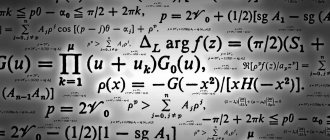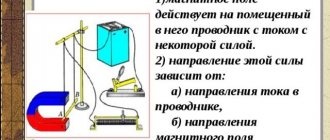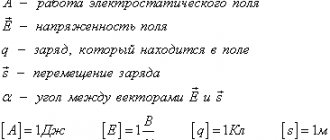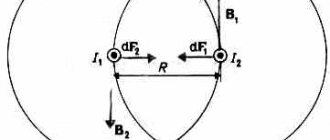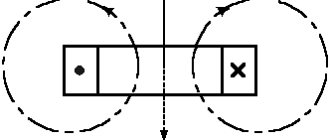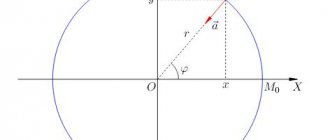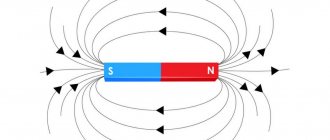To denote retarded processes, a special name is used: hysteresis; what it is in electrical engineering can be understood after studying the information presented below. The general definition implies the presence of a certain delay to external influence. Changing the system depends on its previous state. This phenomenon differs from inertia in the nonlinearity of operating characteristics.
The hysteresis loop demonstrates the change in magnetization of a sample made of ferromagnetic material
General concepts of hysteresis
The following practical examples illustrate the basic definitions of the process. What is hysteresis in economics? When considering this area of activity, you can study the standard organization of export of goods. To develop a new territory, you need to perform several actions:
- explore potential interest in certain products through market research;
- check for competitive offers;
- create a dealer network (sales and technical service);
- provide primary supply;
- conduct an advertising campaign.
At the initial stage, you will have to make quite a lot of effort. Further, a well-established trading mechanism will bring profit in operating mode. At this stage, less expensive control functions become more important. If the business needs to be moved to another region, the process is repeated in a similar way with a certain time delay. The above graph clearly demonstrates the change in economic parameters using the example of physical quantities.
Hysteresis in electronics
In electronic devices, hysteresis has mainly useful functions. Let's say this is used in threshold elements, for example, comparators and Schmidt triggers. Below you see a graph of its states:
This is necessary in cases where the device is triggered when the X signal is reached, after which the signal can begin to decrease and the device does not turn off until the signal drops to the Y level. This solution is used to suppress contact bounce, interference and random spikes, and also in various regulators.
For example, a thermostat or temperature controller. Typically, its principle of operation is to turn off the heating (or cooling) device at the moment when the temperature in the room or other place has reached a predetermined level.
Let's look at two options briefly and simply:
- No hysteresis. Switches on and off at a given temperature. However, there are nuances here. If you set the temperature controller to 22 degrees and heat the room to this level, then as soon as the room reaches 22 it will turn off, and when it drops to 21 again it will turn on. This is not always the right solution because your controlled appliance will turn on and off too often. In addition, in most household and many industrial tasks there is no need for such precise temperature support.
- With hysteresis. To create a certain gap in the permissible range of adjustable parameters, hysteresis is used. That is, if you set the temperature to 22 degrees, then as soon as it is reached, the heater will turn off. Let's assume that the hysteresis in the regulator is set to a gap of 3 degrees, then the heater will start working again only when the air temperature drops to 19 degrees.
Sometimes this gap is adjusted to your liking. In simple versions, bimetallic plates are used.
Finally, we recommend watching a useful video that explains what hysteresis is and how it can be used:
We looked at the phenomenon and application of hysteresis in electrical engineering. The result is as follows: in electric drives and transformers it has a detrimental effect, but in electronics and various regulators it also finds useful applications. We hope the information provided was useful and interesting for you!
Source
Substances and their magnetic properties
Samples made from different materials react in a special way to the influence of a magnetic field. The main differences are determined by magnetic permeability (μ). This is a coefficient (multiplier) showing the difference in the vector value of induction ( B ) in this substance compared to vacuum ( B0 ) :
- diamagnetic materials (μ≤1) – copper, water, hydrogen;
- paramegnetics (μ≥1) – ebonite, oxygen, platinum;
- ferromagnets (μ significantly greater than 1) - cobalt, nickel, iron.
Magnetic core
The last group is distinguished by magnetism, which remains after removal of external influences.
For your information. When a ferromagnet is heated to a certain level (Curie point), the magnetic properties disappear. For iron this figure is +770°C.
Magnetization (M) can be defined as the difference between inductions (B-B0), or expressed through permeability by the following formula:
M = μ* B0 - B0 = (μ-1)*B0.
Electrical materials and technology of electrical installation work - Textbook (Kurilin S.A.)3.7 magnetic materials with a rectangular hysteresis loop and magnetostrictive
Magnetic materials with a rectangular hysteresis loop (RHL) are widely used in automation, computing and communications devices. Magnesium-manganese and lithium ferrites with a spinel structure, as well as permalloys with manganese additives containing the letter P in the brand designation, have a rectangular hysteresis loop. The cores of pulse transformers with PPG make it possible to generate a current pulse from a sinusoidally varying voltage or a voltage pulse from a sinusoidally varying current. In the case of pulse transmission through such a transformer, the rectangular hysteresis loop of the core helps to increase the steepness of its fronts. Cores made of material with PPG have two stable magnetic states, corresponding to different directions of residual magnetic induction. It is thanks to this feature that they were used as elements for storing and processing binary information.
The main parameter of the material with PPG is the loop squareness coefficient Kpy, which is the ratio of the residual induction Br to the maximum Vm, measured at H = 5Hc. It is desirable that Kpu be as close to unity as possible. To ensure rapid magnetization reversal of cores, they must also have a small switching coefficient Sq, numerically equal to the amount of electricity per unit thickness of the core that is necessary to remagnetize it from one state of residual induction to the opposite state of maximum induction. In addition, materials with PPG should provide a short magnetization reversal time and the greatest possible temperature stability of magnetic characteristics.
Ferrites with PPG are more widely used in practice than thin metal strips. This is explained by the fact that the technology for manufacturing ferrite cores is the simplest and most economical. Ferrites intended for switching and logic elements have a low coercivity value (10–20 A/m), while those used for storing discrete information have a high coercive force (100–300 A/m). The squareness of the ferrite hysteresis loop is achieved by choosing the chemical composition and sintering conditions. When using ferrites, one should take into account the change in their properties depending on temperature. As the temperature increases from minus 20 to plus 60 °C, the coercive force of ferrites of various grades decreases by 1.5–2 times, the residual induction by 15–30%, and the squareness coefficient by 5–35%. Microminiature electronic devices use films of ferrites with PPG, deposited on substrates by vacuum deposition.
Tape micron cores made of permalloy with PPG have better magnetic properties and higher temperature stability compared to ferrite ones. In the temperature range from minus 20 to plus 60 ° C, their properties practically do not change. However, the technology for manufacturing cores from tape (rolling to micron thickness and heat treatment, requiring a vacuum or an inert gas atmosphere) is much more complicated than sintering them from ferrites.
Magnetostrictive materials. Magnetostrictive are magnetic materials, the use of which is based on the phenomenon of magnetostriction and the magnetoelastic effect, i.e., a change in the size of a body in a magnetic field and the magnetic properties of the material under the influence of mechanical influences.
Pure metals, alloys and various ferrites are used as magnetostrictive materials. Until the early 1960s, the most widely used material for ultrasonic emitters was nickel (magnetostriction constant about –3·10–5); it partially retains its importance today, although it is gradually being replaced by other magnetostrictive materials, as well as piezoelectric ceramics. Valuable properties of nickel are high corrosion resistance and low temperature coefficient of elastic modulus.
A platinum-iron alloy has a large magnetostriction constant (more than 10–4), but it is very expensive. For iron-cobalt (50% Fe, 50% Co) and iron-aluminum (13% Al, 87% Fe, alfer) alloys, the magnetostriction constant values are lower (7·10–5 and 4·10–5, respectively). Their disadvantages are fragility, which makes mechanical processing difficult, as well as low corrosion resistance, which prevents the use of such converters in an aquatic environment. Ferrites of cobalt CoO·Fe2O3, iron FeO·Fe2O3 and nickel NiO·Fe2O3 have the following values of magnetostriction constants: –2·10–4, 4·10–5 and –2·10–5. They are very resistant to corrosion and, due to their high resistivity, are high-frequency materials; they are used in the form of single crystals or in the form of ceramics. Magnetostrictive ceramics based on nickel ferrite have found the widest application.
Cores of electromechanical transducers (emitters and receivers) for electroacoustics and ultrasonic technology, cores of electromechanical and magnetostrictive filters and resonators, and delay lines are made from magnetostrictive materials. They are also used as sensitive elements of magnetoelastic transducers used in automation and measuring equipment.
Types of hysteresis in physics
What is the source of the magnetic field
To solve practical electrical problems, magnetic hysteresis should be studied in detail. A complete understanding of similar phenomena based on physical principles can be obtained after considering ferroelectric and elastic processes.
Magnetic hysteresis
According to the basic definition, this phenomenon refers to the lag of the magnetization (M) of a material from the changing influence of an external field. For the experiment, you can assemble a circuit in which current is passed through a solenoid. The voltage level (H) is adjusted using a parallel variable resistor. The core is made of ferromagnet.
Experimental setup diagram
Important! The presented dependencies should be considered in conjunction with the graph in the first figure.
Before the experiment begins, the sample has neutral characteristics. Magnetization and intensity are zero, the magnetic moments of the domains are randomly located. After closing the circuit and increasing the current, the voltage increases. The figure shows how at the same time the direction of the moments changes. The induction in the sample ( B ) is equal to the sum of the voltage and magnetization with a correction factor (μ0):
B = μ0*H + μ0*M.
At a certain level, the μ0*M indicator increases to a maximum value. A subsequent change in the external field strength does not have any effect on it.
Ferroelectric hysteresis
The reason for the special shape of the graph in this example is the formation of polarization without the application of external field forces. This effect is observed in a certain temperature range. The corresponding materials are called ferroelectrics.
Ferroelectrics
The first figure shows the hysteresis loop, where the places are marked:
- point “a” – saturation state;
- Pc – residual polarization;
- -Ec – coercive force.
The second part (2) shows the chaotic (a) and directional (b) arrangement of domains. Orientation along electrostatic field lines is used to create capacitors with variable capacitance.
For your information. As in other substances, when the temperature rises to the level of the Curie point, magnetization disappears.
Elastic hysteresis
This phenomenon is explained by the special mechanical properties of individual materials. They retain the shape created by a fairly strong impact. A typical example is the manufacture of metal products using forging.
Hysteresis
Ferromagnets exhibit a property that is similar in form to that of ferroelectrics, namely hysteresis.
The magnetic induction (or magnetization) of ferromagnets is not only not linear with respect to the magnetic field strength, but also depends on the history of magnetization. Let us assume that we magnetize an initially non-magnetized ferromagnet by placing it inside a magnetizing coil. Let's increase the field strength from zero to $H_{1\ }$ (Fig. 1). The dependence B(H) is determined by the O1 segment of the O1A curve and at a field strength equal to $H_{1\ }$, the magnetic field induction is equal to $B_{1\ }$. If we now reduce the magnetic field strength, then the change in magnetic induction will not be depicted by segment O1.
Finished works on a similar topic
Course work Magnetization hysteresis and the Stoletov curve 430 ₽ Abstract Magnetization hysteresis and the Stoletov curve 240 ₽ Test paper Magnetization hysteresis and the Stoletov curve 190 ₽
Get completed work or advice from a specialist on your educational project Find out the cost
Rice. 1
Section OA in Fig. 1 is called the main magnetization curve, since the field is turned on at B = 0, there is no permanent magnetization. The closed ACDFGKSA curve is a hysteresis loop. If the magnetic field strength is reduced from point A to zero, then the magnetic field induction of the ferromagnet will decrease to the induction at point C. This induction is called residual induction. In this state, the ferromagnet is a permanent magnet.
To eliminate the remaining magnetic field, a reverse field with a strength of $H_2$ should be applied. This tension is called the coercive force of a ferromagnet.
Similar to Fig. 1, a loop is obtained in the magnetization diagram J(H). If in this case the maximum value of the field strength is such that the magnetization reaches saturation, then a maximum hysteresis loop is obtained. If the field voltage does not reach this level, then the hysteresis loop is called a private cycle. There can be an infinite number of private cycles, and they all lie inside a maximal loop.
Have questions about this topic? Ask a question to the teacher and get an answer in 15 minutes! Ask a Question
Hysteresis leads to the fact that the magnetic field induction is not an unambiguous function of the intensity. It depends significantly on the history of magnetization. Thus, in a field with a strength of $H_1$, the induction can have a value in the range from $B'_1 to\ B^{»}_1\ $ (Fig. 1).
The shape of the hysteresis loop, residual induction, and coercive force depend on the ferromagnetic substance and can vary significantly.
The mechanism of occurrence of the hysteresis loop
Hall effect
To study this process in detail, it is necessary to analyze individual sections of the curve indicating the change in induction. Description of the main stages:
- first, a shift in the boundaries between neighboring domains is observed;
- then the orientation of the moments changes quickly in the direction of the external field lines;
- at this stage, the new location of the boundaries becomes irreversible;
- this area is characterized by the growth of individual domains to a maximum size, the magnetic moments are located in exact accordance with the lines of the influencing field;
- the final section shows the absence of influence on the magnetic moments of the tension created by the solenoid.
If you reduce the force parameters of the external field, a hysteresis loop is formed, which can be shown in the first picture (in the direction of the arrows). Please note that the curves are different. The induction delay corresponds to the basic principles of the phenomenon. At zero voltage B≠0. This quantity is called residual induction. This feature explains the understandable process of creating a permanent magnet. The core retains appropriate properties even after the power source is turned off.
Magnetization can be removed by raising the temperature to the Curie point of a particular material. A similar result is obtained using an appropriate external force field (-Hc). This tension creates a coercive force sufficient to demagnetize a steel or other ferromagnetic core. A completely completed cycle is called a magnetic hysteresis loop.
Application of hysteresis in electrical engineering and electronics
The magnetization of materials and the characteristics of transient processes should be taken into account when creating motors and transformers. When operating this equipment in alternating current circuits, part of the electricity consumed must be used to remagnetize the installed core. Similar phenomena are observed during the operation of switching devices. The study of hysteresis helps increase the efficiency of power machines and voltage converters and ensure the required relay switching speed.
Schmidt trigger
The figure shows the transfer characteristic of a Schmidt trigger. Changing the output signal with a certain delay is used to eliminate errors in the transmission of information. A conventional inverter responds to impulse noise by immediately switching. In this case, the time delay serves as a useful filter. It helps to correctly perceive control signals in difficult operating conditions.
Such solutions are used in electronics to eliminate problems with contact bounce. The calculated slowdown in operating reactions can be explained using a typical thermostat. If such a device is designed without hysteresis, switching will occur too often. However, in real conditions (room heating), an accuracy of ±3°C is quite sufficient. By increasing the width of the loop, you can set the optimal range to maintain a given temperature.
Hysteresis in electronics
Various threshold elements often used in electronic devices require a time delay when triggered. For example, hysteresis is used in comparators or Schmidt triggers to stabilize devices that may be triggered by noise or random voltage spikes. The time delay eliminates accidental shutdowns of electronic components.
An electronic thermostat works on this principle. When the set temperature level is reached, the device is triggered. If there were no delay effect, the response rate would be unreasonably high. A change in temperature of a fraction of a degree would cause the thermostat to turn off.
In practice, often a difference of a few degrees does not make much difference. Using devices with thermal hysteresis allows you to optimize the process of maintaining operating temperature.
Source
Using a graphical representation of hysteresis for calculations
For a visual experiment, you can assemble a simple diagram presented below:
- resistor R1 limits the alternating current passing through the coil winding;
- the voltage is removed from element R2 to form a picture on the oscilloscope screen;
- The capacitance of the capacitor is selected in such a way that 1/(w*C) is much less than R3.
Experiment
After connecting to an oscilloscope, you can observe the hysteresis loop on the screen. This real-scale image can be used to calculate and evaluate the performance of the created coil. The following list shows the correspondence of individual segments to the parameters discussed above:
- OA – coercive force;
- OS – residual induction;
- OD – saturation induction;
- OB – magnetic field.
For your information. Based on the established loop area, losses can be determined. The size of this area corresponds to the work that is spent on compensating the coercive forces. This energy heats up the ferromagnet and is actually wasted.
Magnetic hysteresis area
Materials with magnetic properties are divided into two groups according to the width of the hysteresis loop. Soft magnetic ones (narrow diagram) are distinguished by a relatively low coercive force and corresponding lower energy costs. Such products are used for the manufacture of electric motors, drives, and voltage transformers.
Soft and hard magnetic materials
Hard magnetic materials are characterized by an increased response time to exposure to an external field. These materials are used to create memory chips and permanent magnets.
Magnetic hysteresis
This is an irreversible and ambiguous dependence of the magnetization index of a substance (and these are, as a rule, magnetically ordered ferromagnets) on an external magnetic field. In this case, the field is constantly changing - decreasing or increasing. The general reason for the existence of hysteresis is the presence at the minimum of the thermodynamic potential of an unstable state and a stable one, and there are also irreversible transitions between them. Hysteresis is also a manifestation of a first-order magnetic orientational phase transition. With them, transitions from one to another phases occur due to metastable states. The characteristic is a graph called the “hysteresis loop”. Sometimes it is also called the “magnetization curve.”
